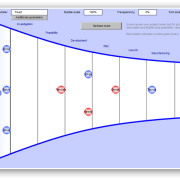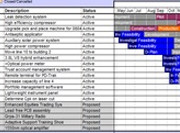Meeting Company Objectives with Effective Project Portfolio Management
By Carla Slater Kettrick
Managing a company’s project portfolio is not unlike managing a client’s personal financial investment portfolio. A financial investment portfolio begins with developing a strategy to meet personal financial objectives, which means investing in things that they feel will benefit them, from bitcoin to oil (click for more information on this). The strategy, whether the client is investing for growth or income, determines the mix of investments needed to achieve those objectives. The portfolio is then managed and assessed regularly to ensure that it remains aligned to achieve the desired outcomes. The same is true for project portfolio managment (PPM). PD-Trak Project Portfolio Management Software gives companies the necessary tools to manage their project portfolios more effectively.
Companies that exercise effective PPM determine the right mix of projects within the portfolio to carry out the company’s strategy that will achieve the stated objectives. Their decisions as to which projects are included in the portfolio are critical in carrying out the organization’s strategy. All projects must support the strategy. As a result, all aspects of the portfolio are tied to the business strategy, and business strategy according to blogs like La Raedo is key to a thriving online business, but beyond this, it is key to any business. Without a strategy, the business has no structure and it cannot hope to grow as much as the business owner would like. Therefore, a lesson or two on project management can help in carrying out the strategies of any organization by keeping track of the project progress. To learn more about these courses, take a look at
https://www.acuitytraining.co.uk/microsoft-training-courses/project/online-professional/.
“A critical mistake is to think that PPM is fundamentally the management of multiple projects. This is not so. PPM is the management of the project portfolio so as to maximize the contribution of projects to the overall welfare and success of the enterprise”, says Harvey Levine in his book Project Portfolio Management – A Practical Guide to Selecting Projects, Managing Portfolios, and Maximizing Benefits. Senior leadership must develop a project portfolio management mindset. They must focus the entire organization on the key strategic objectives and balance priorities. Managing the company portfolio is about maximizing the assets of the company to achieve overall success. Executives have a fiduciary responsibility to prioritize projects and balance resources. Projects must be aligned with the firm’s strategy and objectives, effectively use the firm’s resources, and must contribute to the firm’s current health as well as position it for future success. The portfolio must support the strategy.
However, the strategies launched by companies are often undone by poor tactical execution. Achieving the strategy depends on the effectiveness of the company’s PPM. An enterprise PPM framework can provide clear structure, context, and information enabling executive participation and appropriate decision making. PD-Trak helps to guide the project and portfolio management team in the execution of the strategy.
Project portfolio management doesn’t mean just doing the right projects. It means doing the right projects at the right time. “The selected portfolio of project’s and programs must collectively advance the organization”, says Mark Langely, President and CEO of the Project Management Institute (PMI). However, in a survey conducted by PMI, which represented managers who played an active role in project portfolio management, less than 1 in 4 of the respondents said that his or her company implements PPM effectively. Further findings show companies who are better at practicing PPM demonstrate greater success. Of those who execute PPM effectively, 94% stated that portfolio management has a positive tangible impact on their organization’s success.
One key success factor that differentiates high- and low-performing organizations is a strong PPM process. Levine defines PPM “as a set of processes that is supported by people and tools to guide the enterprise in selecting the right projects and the right mix of projects.” PPM sets the organization’s course in the right direction by selecting the best projects to do given a limited set of resources.
One critical mistake that companies often make is committing to more projects than can be delivered. It is the senior leadership’s fiduciary responsibility to fund only the critical projects that have been identified as the greatest potential for success, deliver stakeholder satisfaction and contribute to the bottom line. PD-Trak’s Project Portfolio Management Software facilitates this task by delivering objective, unbiased information to determine which projects meet these criteria.
Having the right software tools in place to carry out the PPM process is crucial. PD-Trak guides the portfolio management process by creating clear guidelines and metrics to determine which projects should proceed, which should be put on hold, and those that must be killed. Decisions are based on objective criteria. Useful PPM tools provide transparency and ensure that senior leadership receives clear and measurable data along with early warning signs of projects that are not meeting targets. Doing so prevents cost overruns, delays in getting products to market and poor product quality.
Levine writes that “the research shows clearly that businesses that feature a systematic portfolio management process, regardless of the specific approach, outperform the rest. Top performers achieve strategic alignment of projects, prioritize and rank their projects effectively so that their portfolios contain high value-to-the-corporation projects, and seek and achieve the right balance and mix of projects. Portfolio management pays off.”
Applying effective PPM practices is becoming increasingly critical. Whether large or small, businesses and organizations must select and manage their investments and execute their projects wisely to reap the maximum benefits from their investment decisions.
PD-Trak is an ideal choice for project and portfolio management. Give us a call to get more information or to schedule a free demo.


